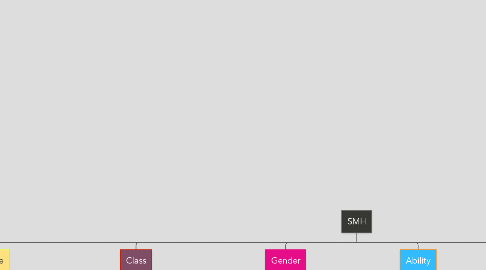
1. Race
1.1. Cultural Sensitivity
1.1.1. Non-judgemental, accepting staff attitudes
1.1.2. Parenting Practices (Westernized Only)
1.1.3. Holidays (Christian Only)
1.1.4. Aboriginal Land Acknowledgement
1.2. Policies
1.2.1. Cultural compotency policies
1.2.2. Non-judgemental values
1.2.3. Equitable hiring policies
1.3. Next Steps
1.3.1. Explore ways to celebrate cultural diversity
1.3.1.1. Client origin map display
1.3.1.2. Cultural foods
1.3.1.3. Staff education on cultural parenting practices
1.3.1.4. Being aware of culturally sensitive community resources
1.3.2. Equitable hiring policies put in place
1.3.3. Ensure pictures/videos in programs include diverse ethnicities
2. Gender
2.1. LGBTTQ
2.1.1. Welcoming to LGBTTQ clients
2.1.2. Collaborates with LGBTTQ supportive external agencies
2.1.3. No staff training requirements
2.1.4. No specific policies to LGBTTQ populations
2.1.5. Does not address LGBTTQ challenges in group settings
2.2. Males
2.2.1. Male only supports available
2.2.1.1. Information for offsite male only groups
2.2.2. Groups available to include male partners
2.2.3. However, if not with a partner cannot attend certain groups (i.e. transitions)
2.2.4. No male only groups run AT SMH
2.2.5. Not the same amount of support for male partners
2.2.6. No supports specific to non-biological fathers raising children
2.3. Inclusive Language
2.3.1. Uses "partner" to refer to couples
2.3.2. Encourages children to play with all toys
2.3.3. Encourages supportive, non-judgemental language and behaviours
2.4. Women
2.4.1. Knowledge of alternate birthing referrals (Birthing companions)
2.4.2. Limited access to alternate birthing methods (Western only)
2.4.3. Women focused
2.5. Next Steps
2.5.1. Advertise LGBTTQ inclusivness
2.5.1.1. Provide LGBTTQ training for staff
2.5.2. Provide LGBTTQ training for staff
2.5.3. Use LGBTTQ couple examples in groups
2.5.4. Provide more supports for male partners, during all stages of relationships
2.5.4.1. Look at if there is a need for programs for non-biological fathers who are parenting
3. Adultism
3.1. Staff
3.1.1. Variety of life stages
3.1.2. Includes students and volunteers in all stages of life
3.1.3. Advocate for "voice" of children
3.1.3.1. Neutral language in child care
3.1.4. Comfortable balance between expert and learner in informal and formal settings
3.1.4.1. Child development room vs Lunch room
3.1.5. Let parents parent without "Stepping in" as expert
3.1.6. Collaborative problem-solving approaches first reaction
3.2. Policies/Values
3.2.1. Strength based
3.2.1.1. Don't appear to be "masters" (children and youth are seen to have their own power, knowledge, and capabilities)
3.2.2. Non-judgemental values
3.2.2.1. Attitudes towards youth
3.2.2.2. However, at times can jump to conclusions based on judgement of clients (ie. child developmentally delayed- assume FAS)
3.2.3. Out of date policies around youth friendly tools relevant to contemporary environments
3.2.3.1. No social media policies
3.3. Programs
3.3.1. No opportunities for adult alumni
3.3.1.1. Could be seen as not capable enough to be mentors
3.3.2. Voluntary to join
3.3.2.1. Clients are capable to make their own choices of their own lives
3.3.3. Intakes
3.3.3.1. Choice to give or not give out information without penalty
3.4. Next Steps
3.4.1. Client participation in agency research/when deciding what programs to offer
3.4.2. Social media usage/policies
3.4.3. Explore language support options in community (ie. price of translators ext)
3.4.4. Alumni participation- empowering to post clients
4. Class
4.1. Policies/Values
4.1.1. Non-judemental values
4.1.1.1. Strength-based values
4.1.2. Strength based values
4.2. Awareness of client socioeconomic demographic needs
4.2.1. Food Access Programs
4.2.1.1. Non-judgemental Food Bank access
4.2.2. Location
4.2.2.1. Healthy lunch and snacks provided
4.2.2.2. High-needs area for low-income
4.2.2.3. Variety of services available in one place (saves travel expenses)
4.2.2.4. Staff sometimes offer emergency transportation depending on context
4.2.3. Life Skills Programs
4.2.3.1. Budgeting programs (Budgeting Blues, Food on the Cheap ext)
4.2.3.2. Room set up often in circles (open space, minimize power differences between clients and facilitator)
4.3. Staff
4.3.1. Variety of backgrounds
4.3.2. Some can appear "flashy" of socioeconomic status
4.4. Next Steps
4.4.1. Appeal to clients in wider socioeconomic range
4.4.2. Use of volunteers from a variety of backgrounds to decrease socioeconomic power differences
4.4.2.1. Alumni program
5. Ability
5.1. Location
5.1.1. Several services available at 1 location- easier travel for physical/intellectual challenges
5.1.2. No supports available for those unable to take public transit
5.2. Supports
5.2.1. Programs focused on coping with mental (dis)abilities
5.2.1.1. Anxiety program: FRIENDS for Life
5.2.2. Individual supports for Mental Health
5.2.2.1. Support Counsellors
5.2.2.2. Adolescent Mental Health (Dr. Harrison)
5.2.2.3. Limited supports for older clients
5.2.2.3.1. Partnerships with external services
5.2.2.4. Addictions Counsellor onsite
5.2.3. Accommodations for physical disabilities
5.2.3.1. Elevator for upstairs services
5.2.3.2. Flat surface at building's entrance
5.2.3.3. No on site supports for seeing or hearing impairments
5.2.3.3.1. No brail
5.2.3.3.2. No ASL translator
5.2.3.4. Groups accommodated to require minimal physical movement
5.3. Policies/ Values
5.3.1. Non-judemental values
5.3.2. Strength-based values
5.3.2.1. Does not see pregnancy as a (dis)ability
5.3.3. Mandatory provincial training for working with individuals living with a (dis)ability
5.4. Next Steps
5.4.1. OC Transpo bus training
5.4.2. Include/expand services for seeing/hearing impairments
5.4.3. On site MH services for older clients
5.4.3.1. Advocate for expansion of Addictions services
6. Language
6.1. Bilingual services
6.1.1. French and english signs throughout building
6.1.2. Limited supports for french speaking clients
6.1.2.1. Programs and individual supports
6.1.2.2. Includes school (and clinics?)
6.1.3. No options for services in any language other than english and french
6.1.4. No language supports for non-verbal languages (ASL, Brail)
6.1.5. Policies
6.1.5.1. Offer when available, but not priority
6.2. Language Intentions
6.2.1. Strength-Based values
6.2.1.1. Notes written in strength based lens
6.2.2. Gender neutral language used for clients and children
6.3. Next Steps
6.3.1. "Sensitivity" type training to be more aware of appropriate language
6.3.2. Partnerships with translation services
6.3.3. Mindful of language when hiring
